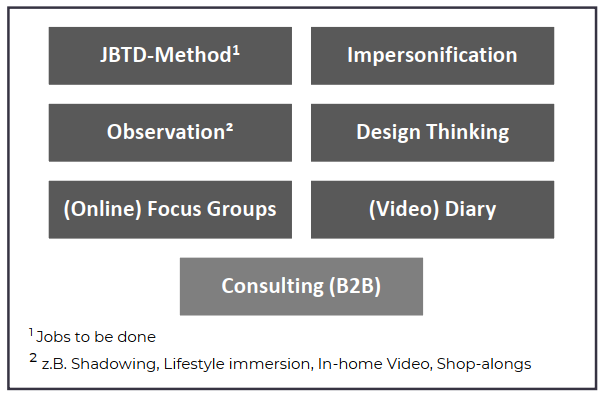Few companies know their customers personally to a degree of detail that they really know who their customers are. Or even what specific tasks and problems their customers face, what motivates them, what annoys them or what they expect. In summary, we need to look behind the facade of the customer.
In order to make a company customer-centric, however, this is precisely the most important step after the most valuable customer groups for the company have been identified: the in-depth analysis of the people we want to address with our products and services. We need to know their behavior patterns, understand their needs, see through their drive.
Analysis Part One: The Visible
By analyzing data sources that provide insight into customer behavior, we try to identify patterns and preferences. The focus is not so much on customers as individuals but on consolidated groups with a large number of underlying data points. From sales, frequency and timing of purchases to interests, income and other demographic information, all of these can be analyzed with relative ease today. Customer data is available from a wide variety of external and internal sources.
Selection of sources for customer data

So, we learn a lot about what our customer does, how old they are, where they live, where and how they shop, how long they spend surfing the web, and much more.
But, this information alone, will not provide us with helpful starting points for new products, communication strategies or service. Why not? They only show us how the customer behaves, they show correlations, but not causalities. The „why“ is therefore missing.
The valuable is the detail
„If companies want to understand consumers, big data offers a valuable, but incomplete, solution.” writes Martin Lindstrom in his book „Small Data“ and beautifully demonstrates how he uses supposedly small, because individual, insights into the lives of consumers to provide global companies with crucial customer insights for product development and marketing campaigns.
Analysis part two: behind the facade of the customer
It is important that we look behind the facade of the customer and find out what kind of problem or task the customer must solve. What motivates his behavior or what are his hidden wishes and dreams?
Only when we know this, we can understand how to support the customer in his plans.
We must look behind the facade, probe and question, to understand the “why” in addition to the “how”.
What do we need to understand?

Fortunately, there are good and proven methods for this that can be drawn upon to better understand customers.
Selected methods for in-depth analysis of customers

In an intelligent combination of qualitative insights (usually collected with rather small case numbers) with behavioral data (based on larger case numbers), key insights can be gained for entire customer groups.
The supposedly „small“ insights help to develop offers that are better tailored to the most valuable customers, because they hit the „nerve of the customers“ and do not just try to match their superficially visible behavior.
In addition the combined data also helps us to develop customer profiles, personas* and customer journeys*. These form the basis for the development of marketing activities and communication strategies*. They help other departments of the company, as well as external service providers, to better understand the customers and to address them in a more targeted manner.
But be careful!
All of this should not be a one-time action. Customers are in a state of rapid adjustment. Life situations, wishes and needs change. Companies therefore need to develop a process in which customer insights are continuously collected, analyzed, and checked for changes.
Staying in touch with customers is therefore the key for successful companies.
Sources:
strategyzer: Value Proposition Design
Lewrick, Link, Leifer: Das Design Thinking Playbook
Martin Lindstrom: Small Data
https://www.nielsen.com/
Picture sources:
Header: www.freepik.de, Infographic vector created by stories
Icons: www.flaticon.de
